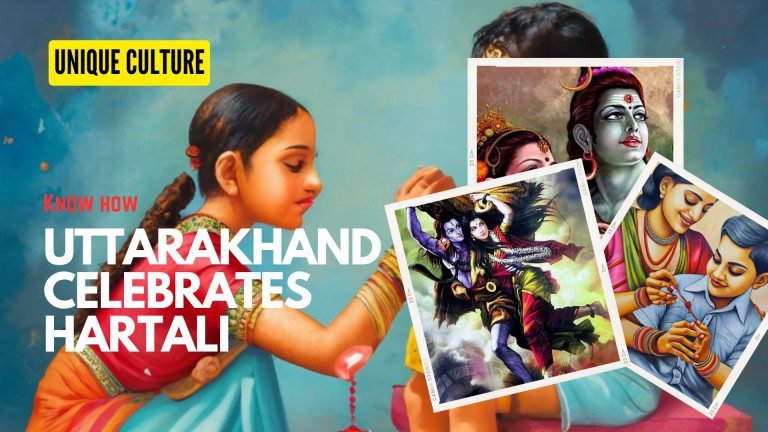
Hartalika Teej, also known as Hartali, is a festival that commemorates the legend of Goddess Parvati’s devotion and love for Lord Shiva. According to the legend, Parvati was in love with Shiva, but her father wanted to marry her to another king. To avoid this, Parvati’s friend took her to a forest and hid her in a cave. There, Parvati made a Shiva linga out of sand and worshipped it with flowers and leaves. Shiva was pleased with her devotion and appeared before her. He accepted her as his consort and married her. The word Hartalika is derived from Harit (abduction) and alika (female friend).
What is Hartalika Teej?
On this day, women observe a strict fast without water and perform puja to Parvati and Shiva. They also listen to the Hartalika vrat katha (story) and sing bhajans (devotional songs). Women wear green clothes and bangles and adorn themselves with jewellery and mehendi (henna). They also exchange gifts with their friends and relatives.
Kumaoni Festivals: A Celebration Of Culture, Nature, And Harmony
Why do Uttarakhandi Pandits celebrate Rakshabandhan on Hartalika Teej?
Rakshabandhan is a festival that celebrates the bond of love and protection between brothers and sisters. On this day, sisters tie a sacred thread called rakhi on their brother’s wrists and pray for their well-being and prosperity. Brothers, in turn, promise to protect their sisters from all evils and give them gifts.
However, Uttarakhandi Pandits have a different way of celebrating Rakshabandhan on Hartalika Teej. They believe that by tying rakhis on each other’s wrists, they are invoking Lord Shiva’s protection for their entire family. They also consider this day as auspicious for starting any new venture or activity.
This tradition has its roots in the ancient times when Uttarakhand was ruled by Katyuri kings. The kings used to send rakhis to their neighbouring kingdoms as a gesture of friendship and peace. The rakhis were also tied on the wrists of the priests who performed the Rudra Abhishekam (a special puja to Lord Shiva) on Hartalika Teej.
Later, this tradition was adopted by the familiar people who started tying rakhis on each other’s wrists on Hartalika Teej, irrespective of gender or age. They also performed the Rudra Abhishekam at their homes or temples, seeking Lord Shiva’s blessings.
How do Uttarakhandi Pandits celebrate both the festivals?
Uttarakhandi Pandits are a community of Brahmins who hail from the Himalayan region of Uttarakhand. They have a unique way of celebrating Hartalika Teej and Rakshabandhan on the same day. They follow the tradition of Upasana Kandi or Samvedi Brahmins, who worship Lord Shiva in the form of Rudra.
On this day, they perform a special puja called Rudra Abhishekam, in which they offer milk, water, honey, curd, ghee, sugar, flowers, fruits, bilva leaves, bhang (cannabis), dhatura (thorn apple), and other items to a Shiva linga. They also chant the Rudram Chamakam, which are hymns from the Yajur Veda that praise Shiva’s attributes and seek his blessings.
After the puja, they tie rakhis on each other’s wrists, irrespective of gender or age. It is believed that by doing so, they are invoking Shiva’s protection for their entire family. They also exchange sweets and gifts with each other. And visit their relatives and friends and share their joy and happiness.
Know more about Hartalika vrat
Why is this tradition unique?
This tradition is unique because it combines two different aspects of Hindu culture: Shaivism (worship of Shiva) and Rakshabandhan (celebration of siblinghood). It also reflects the diversity and unity of India, where different regions have different ways of celebrating the same festivals.
By celebrating both Hartalika Teej and Rakshabandhan on the same day, Uttarakhandi Pandits show their respect and reverence for both Parvati and Shiva and their love and affection for their brothers and sisters. They also demonstrate their faith and devotion to Shiva as the supreme lord who can protect them from all dangers.
This tradition is also a way of preserving their cultural identity and heritage in modern times. It is a reminder of their roots and values, as well as their connection with the Himalayas, where Shiva is believed to reside. It is a way of expressing their gratitude and loyalty to Shiva, who has blessed them with a rich and vibrant culture.
I hope you enjoyed reading this blog post. If you have any questions or feedback, please feel free to leave a comment below. Thank you for your time and attention. 😊